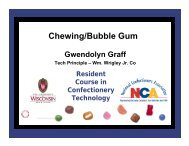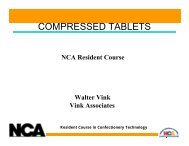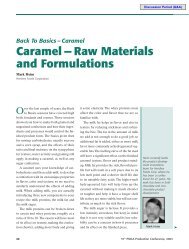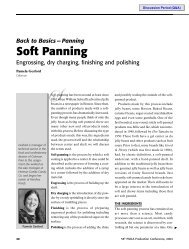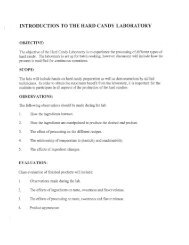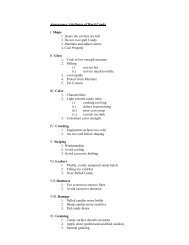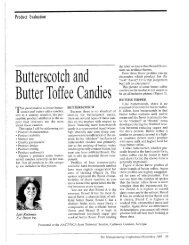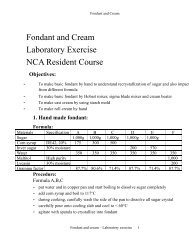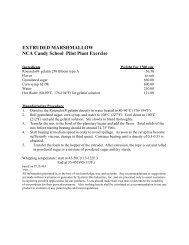2001 Grained and Ungrained Confections - staging.files.cms.plus.com
2001 Grained and Ungrained Confections - staging.files.cms.plus.com
2001 Grained and Ungrained Confections - staging.files.cms.plus.com
Create successful ePaper yourself
Turn your PDF publications into a flip-book with our unique Google optimized e-Paper software.
generally has a coarser particle size distribution<br />
profile than that of a crystallized<br />
fondant.This can be over<strong>com</strong>e by using<br />
st<strong>and</strong>ard high-sugar fondant to replace<br />
powdered fondant in the extruded paste,<br />
making adjustments to the amount of corn<br />
syrup used in the paste recipe to give the<br />
right texture for extrusion.<br />
MARSHMALLOWS —<br />
UNGRAINED AND GRAINED<br />
Marshmallows consist basically of a syrup<br />
(with a moisture content of typically<br />
17–20%), an aerating agent (egg albumen,<br />
soya protein, milk protein isolate or<br />
gelatin) <strong>and</strong> air (which reduces its density<br />
to 0.2–0.6). The aerating agent is a filmforming<br />
material which efficiently mixes<br />
air into the syrup, forming small air bubbles<br />
dispersed throughout the syrup, <strong>and</strong><br />
stabilizing them so that they do not coalesce.The<br />
density of marshmallows <strong>and</strong><br />
their air bubble size distribution play a key<br />
part in their quality.<br />
Egg albumen, soya or milk protein is<br />
generally used for soft, tender mallows,<br />
whereas gelatin is used where a rubbery,<br />
chewy texture is needed, typical in extruded<br />
mallows. Sometimes modified starches, agar<br />
agar <strong>and</strong> gum arabic are also used in<br />
marshmallow recipes to give the required<br />
texture. These are used mostly in <strong>com</strong>bination<br />
with egg albumen or one of the<br />
other aerating agents.<br />
The amount of aerating agent required<br />
ranges from 1–1.5 percent of the final product<br />
for egg albumen, soya protein, lactalbumen,<br />
<strong>and</strong> agar; 2–6 percent for gelatin;<br />
<strong>and</strong> 8–10 percent for starch.The aerating<br />
agents have to be properly resolubilized in<br />
water to be effective.This involves mixing<br />
in water without forming lumps, <strong>and</strong> then<br />
allowing them to st<strong>and</strong> for 1 ⁄2–1 hour before<br />
use. Starch <strong>and</strong> agar require cooking to solubilize<br />
them into the mallow syrup.<br />
The <strong>com</strong>position of the syrup that holds<br />
<strong>Grained</strong> <strong>and</strong> <strong>Ungrained</strong> <strong>Confections</strong><br />
the whole structure together is a critical<br />
variable <strong>and</strong> allows a wide range of mallow<br />
products to be made. When the syrup<br />
is formulated with a high proportion of 42<br />
de corn syrup, typically equal to the sugar<br />
content, it does not crystallize, resulting in<br />
ungrained mallows.<br />
A typical ungrained marshmallow<br />
recipe, suitable for moulding, <strong>and</strong> process<br />
is shown in Figure 13.<br />
When a short-textured marshmallow is<br />
required, the ratio of sugar to corn syrup is<br />
increased <strong>and</strong> fondant is added to the<br />
recipes to induce the syrup to grain. If the<br />
syrup crystallizes too early, aeration be<strong>com</strong>es<br />
more difficult because it loses its elasticity,<br />
<strong>and</strong> the final product is inconsistent.<br />
A typical grained deposited marshmallow<br />
recipe is shown in Figure 14.<br />
Aeration of marshmallow syrups can be<br />
done in several ways:<br />
• A conventional planetary batch mixer<br />
of the Hobart type, fitted with a whisk<br />
to whip in air at atmospheric pressure,<br />
<strong>Ungrained</strong> Marshmallow Recipe<br />
Corn syrup (42 de) 38%<br />
Sugar 22%<br />
Water 6%<br />
Invert sugar 9%<br />
Sorbitol 7%<br />
Gelatin 1.5%<br />
Water for gelatin 6%<br />
Egg albumen 1%<br />
Water for egg 3%<br />
Corn syrup (63 de) 6.5%<br />
Color <strong>and</strong> flavor as desired<br />
Process<br />
The gelatin is dunked in cold water, with rapid mixing,<br />
<strong>and</strong> then allowed to st<strong>and</strong> for 30 minutes.<br />
The egg albumen is dissolved in water <strong>and</strong><br />
warm 63 de corn syrup, first forming a smooth<br />
paste with the egg <strong>and</strong> a small amount of water,<br />
<strong>and</strong> then adding this to the remaining water <strong>and</strong><br />
corn syrup.<br />
The sugar is dissolved in water, the 42 de corn<br />
syrup, invert sugar <strong>and</strong> sorbitol added, <strong>and</strong> the<br />
syrup cooked to 84% s.s.<br />
The syrup is then cooled to 190°F <strong>and</strong> the gelatin<br />
mixed into it, followed by the egg solution.<br />
Color <strong>and</strong> flavor are added <strong>and</strong> the syrup then<br />
whipped to a density of 0.5-0.6 <strong>and</strong> deposited into<br />
starch moulds.<br />
The units are removed from the starch in<br />
24–48 hours ready for finishing <strong>and</strong> packing.<br />
Figure 13<br />
Extruded cremes<br />
are sometimes<br />
regarded as too<br />
coarse in texture<br />
<strong>com</strong>pared with<br />
deposited ones,<br />
which can give<br />
them a lowerquality<br />
image.<br />
55 th PMCA Production Conference, <strong>2001</strong> 51<br />
➤



